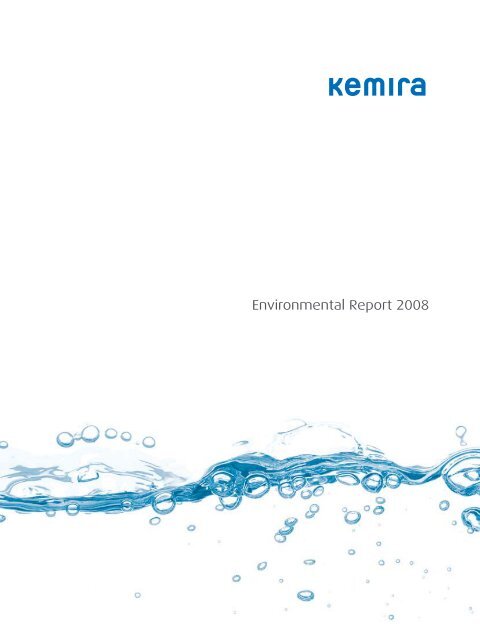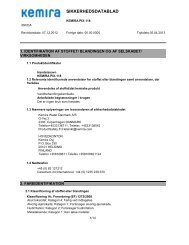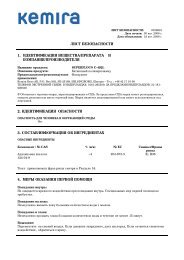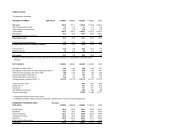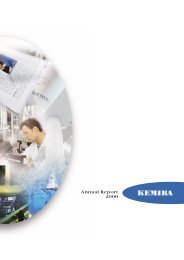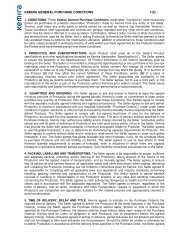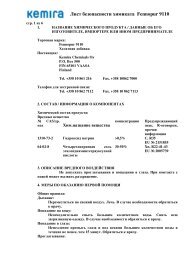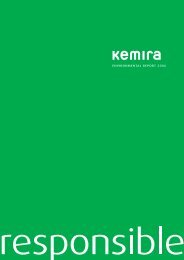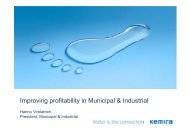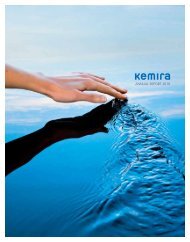Environmental report 2008 (.pdf) - Kemira
Environmental report 2008 (.pdf) - Kemira
Environmental report 2008 (.pdf) - Kemira
You also want an ePaper? Increase the reach of your titles
YUMPU automatically turns print PDFs into web optimized ePapers that Google loves.
<strong>Environmental</strong> Report <strong>2008</strong>
<strong>Kemira</strong> – Expert in Water Treatment<strong>Kemira</strong> offers a comprehensive product range and an extensiveknowledge base in fiber treatment chemistry, chemical water treatmentand water separation technology. Our segments focusing on water andfiber management chemistry are Paper, Water and Oil & Mining.In <strong>2008</strong>, our strategy and structure were transformed withthe objective of strengthening our customer focus andcompetitiveness. Our goal is one unified <strong>Kemira</strong> deliveringcost-efficient and customer-driven solutions globally.Business RestructuringWe focus on businesses that have water technology as theiruniting factor. <strong>Kemira</strong> has a strong competence, leadingtechnology, and an extensive product range in water andfiber management chemistry. Our segments, Paper, Water,and Oil & Mining, can all use the same product know-howand chemistry in their operations which we have builtthrough dedicated research and development work, as wellas numerous acquisitions.Our new business organization will prove beneficial to usin terms of the delivery of chemicals to our customers, inour development of services and tailored solutions and ourpursuit of close customer relationships. The fundamentalpart of the structural change is the creation of global sharedpractices and business processes.Our operations have been divided into four geographicalareas: North America, South America, Asia Pacific, andEurope, Middle East and Africa. Our corporate functions,EHSQ (Environment, Health, Safety, Quality) included, serveall of our segments globally.Expanding <strong>Environmental</strong> Business andReducing EmissionsIn <strong>2008</strong>, <strong>Kemira</strong>’s revenue grew by approximately 0.8% onthe previous year. During the same year, our environmentalrevenue increased to an estimated EUR 1,151 million, representingsome 40.6% of the Group’s total revenue.Meanwhile, direct greenhouse emissions from our operationshave decreased by approximately 95% since year2000. The environmental index representing the Group’senvironmental load showed a decrease of some 3% fromthe previous year. This index consists of seven key emissionsand both non-hazardous and hazardous waste.At our production sites, the lost time incident frequency(LTA1), an indicator of accidents causing an employeeabsence of at least one day, was 4.4 in <strong>2008</strong>, compared to6.5 in the previous year. A long-term positive trend indicatesthat our investment in promoting safe behavior and asafety-oriented culture is bearing fruit.Key Figures<strong>2008</strong> 2007 2006 2005 2004Revenue, EUR million 2,832 2,810 2,522 1,994 2,533<strong>Environmental</strong> Capital Expenditure, EUR million 7.2 30.2 12.2 7.4 10.3<strong>Environmental</strong> Operating Costs, EUR million 30.0 39.1 35.4 33.3 40.4Total <strong>Environmental</strong> Costs (% of revenue) 1.3 2.5 1.9 2.0 2.0<strong>Environmental</strong> Index* 26 27 23 25 50* Year 1997 index was 100.1
Corporate ResponsibilityEnvironment and Safety in the Coreof Our OperationsIn the chemical industry, environment and safety playan important part in corporate responsibility, particularlyconcerning products and their supply chain. With thehelp of water treatment and recycling, we can play ourpart in reducing our customers’ environmental footprint.The <strong>Kemira</strong> Code of Conduct Addresses:We Are Committed to:• Financial <strong>report</strong>ing• Environment, health and safety (EHS)• Business partners• Fair competition• Conflicts of interest and bribery• Support for human rights• Insider information and investor relations• Company assets• Confidentiality and privacy• Reporting procedures• Preventing and minimizing any harmfuleffects of our operations on theenvironment, people and property• Continuously improving ourenvironmental and safety performance• Promoting sustainable developmentby making efficient use of energy andnatural resources• The international Responsible Care (RC)program• To globalizing our certified managementsystems2 <strong>Kemira</strong> <strong>2008</strong>
In the chemical industry, safety and the environment takecenter stage in corporate responsibility. For decades, theindustry has placed its main emphasis on occupational andprocess safety and plant environmental issues, with excellentresults. The most tangible example of this work is the globalResponsible Care program.Safety FirstAt <strong>Kemira</strong>, we continue to improve the systems, attitudes andwork methods related to occupational safety. At our productionsites, the lost time incident frequency (LTA1), an indicatorof accidents causing an employee absence of at least oneday, was 4.4 in <strong>2008</strong>, compared to 6.5 in 2007. A long-termpositive trend indicates that our investment in promoting safebehavior and a safety-oriented culture is bearing fruit. Duringtimes of change, maintaining mental well-being is of utmostimportance. We have met this challenge by providing supportto our employees, in line with local practices and cultures.In process safety, key issues include competence, technologyand the careful operation of our plants. Moreover, wehave allocated more resources to risk analysis and the auditingof process safety. No serious accidents related to processsafety occurred in <strong>2008</strong>.We seek to ensure that our products’ supply chain is safe,fast and cost efficient. Together with our customers, we optimizetransport and storage planning, which indirectly reducesemissions. An analysis of our warehouse and productionnetwork is currently underway, followed by optimization in2009–2010.We endeavor to develop our supply chain, with a particularemphasis on product safety, and strive towards identifyingthe risks posed by chemicals and promoting safe ways ofusing them. In 2006, we set up a REACH competence centerin Espoo with the purpose of implementing the EuropeanUnion REACH chemical legislation in <strong>Kemira</strong>.Water Treatment – Business With <strong>Environmental</strong>ResponsibilityIn our business operations, we emphasize providing solutionsto our customers’ environmental problems. For example, wehelp our customers make better use of scarce resources, decreasetheir waste load through recycling and streamline theirprocesses. Water plays a special role as a common denominatorin our strategy.In skillful hands, chemical water treatment is efficient andsafe. The benefits to society gained from our products aresignificant and tangible. Chemicals used in water treatmentare well known and reliable products, which can be alsomanufactured locally from recycled raw material, creating thecornerstones of sustainability.<strong>Environmental</strong> Risks and LiabilitiesThe bulk of <strong>Kemira</strong>’s business is in the chemicalindustry, whose products and operations are governedby numerous international agreements andregional and national legislation all over the world.The Group treats its environmental liabilities andrisks in financial statements in accordance with IFRSand observes established internal principles andprocedures.Implementation of the EU chemical legislation,REACH, constitutes a key legal process. In <strong>Kemira</strong>,pre-registration was completed according to plan in<strong>2008</strong>, and the registration is now well underway. Incontrast, the legislation on climate change preventionwill have limited direct impact on <strong>Kemira</strong>.Acquisitions and divestments have not had asignificant impact on the Group’s environmentalres ponsibility, with the exception of the newpigment joint venture with Rockwood Inc. It wasagreed that the parties’ closed on-site landfills willbe excluded from the joint venture and the partieswill remain responsible for them individually. <strong>Kemira</strong>Group assumed responsibility over two piling areasin Pori and began their closure in accordance withthe environmental permit in <strong>2008</strong>. A provision forthis was recognized in line with the closing plan.Provisions for environmental remediation totaledEUR 18.8 million. In addition to Pori, the largest provisionsconcerned the remediation of the sedimentin a lake adjacent to the Vaasa plant.In the context of all of its M&A in <strong>2008</strong>, <strong>Kemira</strong>carried out due diligence analyses related to soiland groundwater contamination caused by thesites’ previous operations.In connection to the Group’s environmental<strong>report</strong>ing, a total of three sites <strong>report</strong>ed temporaryexceedances of environmental permits. The authoritiesare aware of these cases and the requiredcorrective actions have been completed or initiated.Emissions AllowancesThe Group holds assigned emissions allowancesunder the EU Emissions Trading System at a singlesite in Sweden. In net volumes, these allowancesat Group level showed a surplus of 2,230 carbondioxide tonnes in <strong>2008</strong>.3
<strong>Environmental</strong> FootprintOur <strong>Environmental</strong> Impact Has Decreased<strong>Kemira</strong>’s carbon footprint has reduced significantly over the years.Along with diminishing waste water releases, our water footprintshows how our products help treat increasingly larger volumes ofwater across the world.The direct greenhouse emissions from our operations havedecreased by approximately 95% since year 2000. Such amarked improvement has been enabled by the divestmentof business operations and the outsourcing of power generationin recent years. One of the most significant factorsaffecting our carbon footprint, electricity, is mainly generatedby nuclear or hydropower. To an increasing extent, heat generatedby our key energy partners is based on renewablefuels, recycled fuels and coal-free process energy. However,all indirect emissions affecting our global carbon footprinthave not been calculated.We are making efforts to increase our self-sufficiencyin terms of electricity, and to further improve our energy efficiency.We are committed to the voluntary energy efficiencyagreement of the Confederation of Finnish Industries EK,in force until the end of 2016. This agreement covers ourproduction sites in Finland.In the future, improvements in energy efficiency will be Euroaincluded in our global management systems, and we willtake steps to enhance the efficiency of our transport logisticsand energy use.Positive Water Footprint – More Clean WaterWhile the carbon footprint is a well known environmentalconcept, the water footprint is a less familiar indicator ofwater use or contamination caused by products, peopleor companies. A positive water or carbon footprint is alsopossible, since products can have a positive impact on theenvironment by cleaning water or absorbing carbon.<strong>Kemira</strong>’s water footprint shows how our products helptreat increasingly larger volumes of our customers’ wateracross the world. Meanwhile, we have significantly reducedwaste water discharges from our production processes byincreasing water purification or recycling and through acquisitionsand divestments, among other things. The end result isa purifying water footprint.Development of <strong>Kemira</strong>’s Water FootprintEuroa97 00 05 0897 00 05 08Waste water releases from <strong>Kemira</strong>’s own productionWaste water purified by <strong>Kemira</strong>’s products4 <strong>Kemira</strong> <strong>2008</strong>
<strong>Kemira</strong>’s Carbon Footprint<strong>2008</strong>1998Our Example of a SmallerCarbon Footprint ProductREACH Pre-Registering CompletedPre-registering was the first stage of implementing theEuropean Union REACH chemical legislation, which tookplace between 1 June <strong>2008</strong> and 1 December <strong>2008</strong>.<strong>Kemira</strong> submitted close to 3,000 pre-registrations,including substances imported to the EU or produced by<strong>Kemira</strong>, and the key raw materials.Preparations for the first-stage registration, to becompleted by 1 December 2010, are well underway.Together with other chemical industry companies, weare involved in developing the registration procedures.Currently, the information exchange forums specified bythe Decree are being set up. During this phase, the finalnumber of registrators and the registration costs willbecome clearer.REACH will significantly increase the need for communicationin the supply chain. In addition to the previousproduct data, the required information will includedata on substances, volumes, usage and exposure, andadministrative registration data. All this is possible onlyby carrying out considerable changes in the <strong>Kemira</strong>information systems.Along with REACH, we are continuing to make effortsto improve product safety, for example by developingproduct management and product safety evaluationprocesses, and paying increasing attention to productsafety in our product development projects.Crystallized calcium sulfate pigment developed by<strong>Kemira</strong>, is a diverse product, which saves both costsand the environment. It can be used both as coatingand as filler pigment for paper.In <strong>2008</strong>, <strong>Kemira</strong> commissioned an external bodyto calculate the carbon footprint of <strong>Kemira</strong>’s calciumsulfate pigment. The findings were compared to thecarbon footprint of a similar calcium carbonate pigment.They show that the production of calcium sulfatepigment produces less greenhouse gases than that ofcalcium carbonate pigment. The carbon footprint was10% smaller for the ground product and 25% smallerfor the precipitated product. Consequently, the carbonfootprint of the paper product was smaller when calciumsulfate pigment was used in production.This carbon footprint calculation included the impactdue to process type, production location and logisticsand energy use.Local Raw MaterialsThe new production process for calcium sulfate pigment,introduced by <strong>Kemira</strong> at the beginning of 2009,is extremely energy efficient, consuming a third lessenergy than previous methods.The raw material for calcium sulfate pigment is calciumsulfate, i.e. gypsum. <strong>Kemira</strong> receives gypsum fromthe Yara phosphoric acid plant, located next to <strong>Kemira</strong>’sSiilinjärvi plant, where it is generated in large quantitiesas a by-product. Consequently, we have a guaranteedraw material supply with a short transport distance.5
<strong>Environmental</strong> BusinessChemistry as a Solution for <strong>Environmental</strong> ProblemsChemicals are often perceived as an environmental problem, while infact they are a vital part of the solution. In <strong>2008</strong>, <strong>Kemira</strong>’s environmentalbusiness accounted for 40.6% of revenue.There is no clear international definition of environmentalbusiness, especially with respect to “green” chemicals. In<strong>Kemira</strong>, we have long followed our own unofficial classificationin order to monitor growth in this application area.Currently, our environmental business can be divided intothree main segments: products used directly in environmentalprotection, such as water treatment chemicals, productsreprocessed from waste, and alternative products competingon the market on the strength of their environmental argument.The latter include products such as chlorine-replacingoxygen chemicals and solvent-free paints.Growth in Water Treatment ApplicationsOur environmental business continued on a long-termgrowth path. In <strong>2008</strong>, our environmental revenue increasedto an estimated EUR 1,151 million, representing some 40.6%of the Group’s total revenue. This represents a growth of 2%from the previous year.Last year, water treatment chemicals represented the keygrowth business in South America, among other geographicalareas. In the Paper segment, the economic downturnwas reflected also in the sales of environmental applications.In contrast, sales of environmentally benign de-icing productsshowed a marked increase.6 <strong>Kemira</strong> <strong>2008</strong>
<strong>Environmental</strong>, Quality and Safety Management SystemsManagement Systems at Production Sites<strong>Kemira</strong> and Lloyds LRQA signed on a global agreement on certifying EHSQsystems at <strong>Kemira</strong>’s plants. Following the Group’s restructuring, our EHSQfunction was reorganized on regional basis.Each geographical area has dedicated individuals and teamsto develop and audit the EHSQ systems for each unit in theregion. At corporate level, the EHSQ function works closelywith the production organization.The Group EHSQ policy has been revised with a specialemphasis on safety, while further harmonization of EHSQpractices and performance indicators is being promoted inour plants. Our objective is to obtain EHSQ certificates to allproduction sites, the number of which totaled 89 at the endof <strong>2008</strong>; the target for 2009 is ten new certificates.At the end of <strong>2008</strong>, 66 sites had a certified environmental,quality or safety management system, and one newcertificate was awarded during the year. No major non-conformitieswere detected in the system maintenance.<strong>Environmental</strong>, Quality and Safety Management Systems at SitesEnvironment ISO 14001Quality ISO 9001Health and Safety OHSAS 1800127%21%56%44%73%79%Site with a Certified SystemSite without a Certified System7
Production Site OverviewEnvironment and Safety at Our SitesWe took many small steps to improve environment and safety at ourproduction sites in <strong>2008</strong>. No major environmental investment projectswere under way.EuropeAt the Prerov and Zelivka plants in the Czech Republic, energyefficiency was improved in the production of water treatmentchemicals, and Prerov obtained permission to processpickling liquors. In Police, Poland, new sewage system wasinstalled and the plant switched to emission-free technologyin the production of sodium aluminate.In Lauterbourg, France, waste volumes were reducedand storage safety improved. In Spain, water managementand filtration efficiency were improved in water treatmentchemicals plants. In Tarragona, preparations were completedto use recycled acid as raw material. The new ferric chlorideplant in Torrelavegas will reduce emissions and make rawmaterial and energy use more efficient.The Botlek plant in the Netherlands implemented processchanges to lower waste water releases, particularly thecopper load in water. An incident involving acrylonitrile andcopper leakage to the site’s treatment plant was <strong>report</strong>ed.The Rosenburg hydrogen peroxide plant installed a catalystdust filter and improved water systems. Furthermore, in Tiel,the volume of waste water to the city water treatment plantwas reduced. An outbreak of fire at one drying line occurredin June, causing some property damage and productionlosses. In the United Kingdom, the Bradford plant enhancedenergy efficiency and continued preparations for replacingzinc in all production lines.In Helsingborg, Sweden, soil investigations continued andsome construction areas were cleaned up. The Fredrikstadplant in Norway initiated the replacement of process chlorinewith oxygen.In Finland, the Kuusankoski plant introduced new equipmentto remove chrome from waste water and renewedpiping systems. The Äetsä plant took measures to enhancewater monitoring, and soil remediation work was continuedon site by former occupants. In Vaasa, the number of occupationalincidents was significantly reduced. No further necessarymeasures were identified in the soil and ground water<strong>report</strong> for the Oulu plants. A noise investigation was carriedout in the hydrogen peroxide plant.The transfer of the Pori titanium dioxide plant to a jointventure caused a substantial change in the releases, wastevolumes and environmental costs <strong>report</strong>ed by the Group.Furthermore, the closing of the iron sulfate landfill on theindustrial site was commenced under the environmentalpermit; a project which will continue for several years. Theclosing will considerably reduce leaching waters and risks inthe area, and recycled materials can be used in the cappingstructure.North AmericaIn Vancouver, Canada, a new thin film evaporator wasinstalled in the paper chemicals plant, reducing the volumeof biosludge. Leakage prevention was improved in our St.Catharines plant, while product changes reduced the plant’sVOC (Volatile Organic Compound) emissions. While the Fon-8 <strong>Kemira</strong> <strong>2008</strong>
casetana plant discontinued the use of chlorine in ferric chlorideproduction, a waste recycling program was introduced in thePrince George plant. In the United States, storage areas wereimproved and soil investigations continued in the Mobileplant.South AmericaWaste recycling efficiency was improved in TelemacoBorba, Brazil, and dust emissions and waste water volumesreduced. In Fray Bentos, Uruguay, the plant introduced a newdrop separator and improved gas scrubbing. In connectionto the Nheel Quimica acquisition in Brazil, a comprehensiveenvironmental analysis was carried out on site and improvementmeasures were planned.Asia PacificNew gas scrubber equipment was introduced in the Yixingplant, and rain and waste water were separated into basins.<strong>Environmental</strong> due diligence investigations were conductedin the region, in connection to acquisitions.TikkurilaTikkurila continued the EHSQ auditing of paint and coatingplants with the key objective of improving occupational safety.The Vantaa site obtained a new environmental permit,and no problems were identified in the external audits ofmanagement systems. In Sweden, the Stockholm unit wasclosed down, and the new plant in Nykvarn manufacturesonly waterborne products. The plant also improves energyefficiency and reduces transportation. In Debica, Poland, soilremediation continued as planned.In Russia, solvent-based production was moved from theRamenskoye plant to St. Petersburg. New logistics centerswill be completed in 2009 in Mytishchi in the Moscow area,and in St. Petersburg. Gamma Industrial Coatings commencedsolvent waste distillation and recycling. In October, TikkurilaPowder Coatings obtained a quality certificate. Currently, allTikkurila’s plants but one have a quality system in place.Energy Efficient Disinfection MethodDisinfection is an efficient method of treating wastewater. However, disinfection methods vary not onlyaccording to their cost but energy consumption andenvironmental impact. <strong>Kemira</strong>’s DesinFix methodrepresents the highest level of disinfectant technology.The product does not generate any environmentallyhazardous by-products or accumulate inthe environment.DesinFix contains formic acid and hydrogenperoxide, which when accurately mixed form ahighly efficient biocide. Compared to the competingUV light or ozone methods, the technology has lowerinvestment costs. Other benefits include energy efficiencyand minimal maintenance requirements.Removing Metals from Pulp WhileProtecting the EnvironmentMetals contained in pulp weaken the performanceof bleaching chemicals. Such metals can be removedby chelating agents, which bind metal ions. Fennobioproducts, which have been developed by <strong>Kemira</strong>,remove harmful metals while protecting the environment.Fennobio products biodegrade faster than conventionalchelating agents and contain significantlyless nitrogen.By switching to Fennobio products, companieswith restrictions on using conventional agents, imposedupon them by the environmental authorities,can also benefit from chelating.9
<strong>Environmental</strong> ReportingMarked Drop in Emissions and Energy UseIn <strong>2008</strong>, revenue of <strong>Kemira</strong> Group grew by 0.8%. The production volumesincluded in the <strong>report</strong>ing fell by some 4% and total energy use by around9%. These changes can be mainly attributed to the Pori M&A transaction.The index representing the Group’s environmental load showed adecrease of some 3% from the previous year. This index consists ofseven key emissions and both non-hazardous and hazardous waste.Greenhouse gas emissions continued to fall, showing areduction of some 8% on the previous year. The currentemission level is only about 5% of that measured in year2000. This reduction can be explained largely by mergersand acquisitions, which have led to a less energy-intensivebusiness portfolio. The volume of other inorganic compoundemissions into the air also dropped significantly. Meanwhile,the decrease in volatile organic compounds (VOC) wasnoticeable, especially in the Group’s paint business. Watervolumes and waste water loads took a downward turnacross the board.The amount of non-hazardous waste decreased sharply,to less than half of its volume last year. In addition to thechange in ownership, sales of the Pori plant’s by-productsshowed a clear increase, reducing the need for waste piling.Consequently, landfill piling decreased by two thirds atGroup level. The volume of hazardous waste decreased bysome 18%, while at plant level both upward and downwardchanges were observed, caused by storage changes, soilremediation projects and other factors.<strong>Environmental</strong> Costs Fell Significantly<strong>Environmental</strong> costs showed a marked decrease from theprevious year, totaling EUR 37.2 million (69.3). <strong>Environmental</strong>investments fell by three quarters, accounting for EUR 7.2million (30.2), and no significant investments were underwayor planned. In 2007, this figure was increased, particularlyby the waste productizing investments in Pori. <strong>Environmental</strong>protection operating costs decreased by some 23%,accounting for EUR 30.0 million (39.1). This drop was mainlyattributed to the Pori restructuring and the lower costs of soilremediation.Our <strong>Environmental</strong> Report deals with the Group companiesin line with financial <strong>report</strong>ing. The <strong>report</strong> has beenprepared in accordance with the following, where applicable:• The Finnish Accountancy Standards Board’s recommendationon the recognition, measurement and disclosure ofenvironmental issues in the annual accounts and annual<strong>report</strong>s of companies, 2003• Cefic (European Chemical Industry Association):Responsible Care Reporting Guidelines 2006• Applicable IFRS guidelines10 <strong>Kemira</strong> <strong>2008</strong>
<strong>Kemira</strong> Group <strong>Environmental</strong> Statistics<strong>Kemira</strong>’s environmental statistics cover 89 production sitesin different parts of the world. Separate warehousing or distributioncenters are not included. In <strong>2008</strong>, 3 plants <strong>report</strong>edfor the first time and 2 plants were closed down.The titanium dioxide production at Pori, Finland, which had asignificant effect on the total volumes, was included in thestatistics for a period of 8 months.Releases into water, tonnes <strong>2008</strong> 2007 2006 2005 2004Chemical Oxygen Demand (COD) 1) 53 69 29 79 309Nitrogen (N) 48 70 87 96 542Phosphorus (P) 0.4 2 4 7 15Suspended solids, 1,000 tonnes 0.5 0.9 0.9 0.9 1.3Metals (Hg+Cd+Pb+Cr+As+Cu+Ni+Zn) 1.2 2.3 2.3 2.0 4.0Releases into air, tonnesParticulates 63 69 40 128 257Sulphur dioxide (SO 2) 2) 1,801 1,957 1,813 3,036 4,330Nitrogen oxides (NO 2) 3) 323 372 298 1,152 2,864Carbon dioxide (CO 2), 1,000 tonnes 205 223 224 805 1,828Volatile organic compounds (VOC) 4) 177 182 171 130 136Volatile inorganic compounds (VIC) 5) 142 144 23 24 1,310Waste 6) , tonnesHazardous wastes, total 9,554 8,073 6,497 5,290 10,310— Off-site landfill 3,269 2,738 2,161 1,316 3,621— Off-site incineration 3,709 3,815 2,332 1,933 4,892— On-site landfill 0 0 35 35 94— Other treatment 2,576 1,521 1,969 2,006 1,704Non-hazardous wastes, 1,000 tonnes 299 639 526 654 1,903Natural resourcesFuel consumption, ktoe 7) 89 107 92 242 427Fuel consumption as raw material, ktoe 83 92 93 81 560Purchased electricity, TJ 10,857 11,082 10,420 9,594 4,137Purchased heat, TJ 6,497 7,340 6,754 1,177 907Cooling water volume, million m 3 , approx. 199 219 213 202 239Waste water volume, million m 3 , approx. 6.0 6.1 5.7 5.4 13SafetyNumber of accidents 8) per million working hours 4.4 6.5 6.0 8.4 6.7Key figures, EUR millionGroup revenue 2,832 2,810 2,522 1,994 2,533<strong>Environmental</strong> capital expenditure 7.2 30.2 12.2 7.4 10.3<strong>Environmental</strong> operating costs 30.0 39.1 35.4 33.3 40.4Total environmental costs, % of revenue 1.3 2.5 1.9 2.0 2.01)Estimate. In this case, partly caused by inorganic discharges.2)All sulphur compounds calculated as SO 2.3)Nitric oxide and nitrogen dioxide calculated as NO 2.4)VOC is a sum of volatile organic compounds as defined inEU Directive 1999/13/EC.5)Sum of ammonia, hydrogen chloride and six other simpleinorganic compounds.6)Reported figures do not include on-site incineration,waste which is further processed into products at thesites, or sold as a co-product to external recycling.Figures are on wet basis.7)1,000 tonnes of oil equivalent. Energy figures for2005–2007 changed due to corrected data fromone site.8)Accidents causing an employee absence of at leastone day (LTA1).11
<strong>Environmental</strong> Graphics<strong>Environmental</strong> IndexGreenhouse Gas EmissionsVOC Emissions1,000 tonnesCO 2ekv.Tonnes12097 04 05 06 07 087,00097 04 05 06 07 0840097 04 05 06 07 08100806040206,0005,0004,0003,0002,0001,000300200100000<strong>Environmental</strong> index consists of sevenkey emissions, and of non-hazardous andhazardous waste. Year 1997 index was 100.N 2 O as CO 2 eq.CO 2Non-Hazardous Waste Generation1,000 tonnes1 000 tonnia97 04 05 06 07 083,000Hazardous Waste Treatment1%19%28%Lost Time IncidentsPer Million Working Hours04 05 06 07 081082,0001,00027%25%640On-site incinerationOff-site incinerationOff-site landfillingRecyclingOther treatment20<strong>Environmental</strong> Operating Costs<strong>Environmental</strong> Capital Expenditure<strong>Environmental</strong> BusinessEUR million6097 04 05 06 07 08EUR million6097 04 05 06 07 08EuroaEUR million1,20097 04 05 06 07 0850501,000404080030306002020400101020000012 <strong>Kemira</strong> <strong>2008</strong>
Independent Assurance ReportTo the Board of Directors of <strong>Kemira</strong> OyjAt the request of <strong>Kemira</strong> Oyj, we have reviewed the informationpresented in <strong>Kemira</strong> Oyj’s <strong>Environmental</strong> Report<strong>2008</strong>. The <strong>Environmental</strong> Report is the responsibility of themanagement of <strong>Kemira</strong> Oyj and has been approved by theBoard of Directors of <strong>Kemira</strong> Oyj. The responsibility of KPMGis to issue an assurance <strong>report</strong> on the information presentedin the <strong>Environmental</strong> Report.completeness of the data in the <strong>Environmental</strong> Report. It isimportant to view the performance data in the context ofthe explanatory information provided by <strong>Kemira</strong> Oyj.To obtain a thorough understanding of the financialresults and financial position of <strong>Kemira</strong> Oyj, the <strong>Kemira</strong> Oyj’saudited Financial Statements for the year ended 31 December<strong>2008</strong> should be consulted.Context and scope of the assurance<strong>Kemira</strong> Oyj’s annual <strong>Environmental</strong> Report consists of dataand statements describing the efforts and progress <strong>Kemira</strong>Oyj has made related to the environmental aspects of itsoperations.<strong>Kemira</strong> Oyj has prepared its <strong>Environmental</strong> Report accordingto its internal <strong>report</strong>ing guidelines as well as according to,where applicable, the Finnish Accountancy Standards Board’srecommendation on the recognition, measurement anddisclosure of environmental issues in the annual accountsand annual <strong>report</strong>s of companies (2006), and the EuropeanChemical Industry Council’s (CEFIC) Health, Safety and <strong>Environmental</strong>Reporting Guidelines (2006).Our engagement was designed to provide limited assuranceon whether the information presented in <strong>Kemira</strong> Oyj’s<strong>Environmental</strong> Report <strong>2008</strong> is fairly stated in all materialrespects.Standards and criteria for the assuranceWe conducted our engagement in accordance with theFinnish Institute of Authorised Public Accountants’ Standard3000 Assurance Engagements other than Audits or Reviewsof Historical Financial Information. Amongst others, thisstandard requires that the assurance team members possessthe specific knowledge, skills and professional competenciesneeded to understand and review the <strong>Environmental</strong> Information,and that they comply with the requirements of theIFAC Code of Ethics for Professional Accountants to ensuretheir independence.The evaluation criteria used for our assurance are the<strong>Kemira</strong> Oyj’s internal <strong>report</strong>ing guidelines as well as the FinnishAccountancy Standards Board’s recommendation on therecognition, measurement and disclosure of environmentalissues in the annual accounts and annual <strong>report</strong>s of companies(2006), and the CEFIC Health, Safety and <strong>Environmental</strong>Reporting Guidelines, where applicable to <strong>Kemira</strong> Oyj’senvironmental <strong>report</strong>ing.Considerations and limitationsData concerning environmental aspects and performanceare subject to inherent limitations given their nature andthe methods used for determining, calculating and estimatingsuch data. <strong>Kemira</strong> Oyj has set out such limitations to theWork undertaken and conclusionsWe reviewed the reliability of the <strong>Environmental</strong> Report<strong>2008</strong> based on reviews of:• the systems and processes used to generate, aggregateand <strong>report</strong> these data and information;• internal documentation• the data <strong>report</strong>ed by <strong>report</strong>ing organizations to corporatelevel, in material respects;• the calculations made at corporate level; and• the data validation processes at corporate level.To gain a deeper understanding on the informationpresented in the <strong>Environmental</strong> Report and related <strong>report</strong>ingprocesses, we have also• discussed with the key people responsible for environmental<strong>report</strong>ing; and• conducted site visits to <strong>report</strong>ing organizations in Helsingborg,Sweden, and Bradford, the United Kingdom.Based on our work described above, nothing has come toour attention that causes us to believe that the informationpresented in the <strong>Environmental</strong> Report <strong>2008</strong>, based on theabovementioned criteria, is not fairly stated in all materialrespects.Helsinki, 24 February 2009KPMG OY ABPekka PajamoAuthorized Public AccountantNina KillströmCorporate Responsibility Advisorwww.kemira.comOn our website’s Responsibilitysection you can find informationconcerning environment and safetyas well as our contact persons inenvironmental issues.


